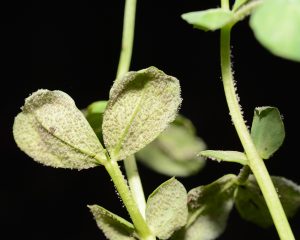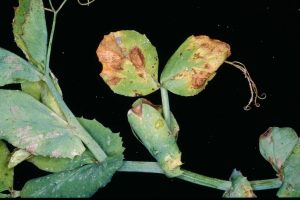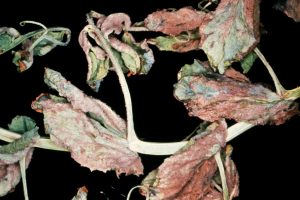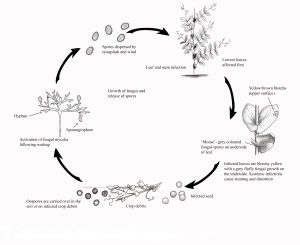Downy mildew, caused by the pathogen Peronospora viciae, is a common disease of field pea in Victoria, South Australia and Tasmania. The disease is favoured by wet, cool seasons. Night temperatures below 10°C and morning dew promotes the disease. The disease also impairs wax formation on the leaves and makes plants very susceptible to herbicide injury. Systemic infection can lead to the appearance of the disease late in the season if conditions are conducive, but yield losses due to downy mildew arise from the stunting of plants early in the season, or from complete loss of seedlings. Substantial losses can occur in cooler districts.
What to Look For
The disease is most common soon after emergence, but may affect plants at any growth stage during periods of moist, cool weather. Early infection causes systemic infection in plants that are a sickly yellowish-green and severely stunted and distorted. The undersides of the leaflets, in particular, are covered with a fluffy mouse-grey spore mass. Infected plants may turn chlorotic while producing an abundant source of spores for secondary infections.
Secondary infection is localised in upper leaves, stems, tendrils and pods and results in the appearance of isolated greenish-yellow to brown blotches on the upper leaf surface. On the lower surface directly below the lesions are masses of mouse grey fruiting bodies that produce spores under wet and cold conditions. Infected pods are deformed and are covered with yellow to brownish areas and superficial blistering. The fungus usually affects the lowest leaves and pods.
Disease Cycle
The fungus that causes downy mildew survives 10-15 years in the soil and also on pea trash. Infection from these sources can lead to systemic and local leaf infections in volunteer pea seedlings. These seedlings act as a source of infection from which the disease spreads by wind to adjacent plants and crops. The disease can develop quickly when conditions are cold (5-15°C) and high humidity (over 90 per cent RH) for 4-5 days, often when seedlings are in the early vegetative stage. Rain is the major means of spore dispersal and infection. Heavy dew will promote sporulation. Dry, warm weather is unfavourable for the disease. Systemic infection of plants can lead to the disease developing late in the season if conditions are favourable.
Generally plants will grow away from the disease as temperatures increase in late winter/early spring without significant yield loss.
Management
Varietal Selection
Growing a resistant field pea variety is the most effective means of controlling downy mildew in districts prone to this disease. There are two strains of the downy mildew fungus, the Parafield and Kaspa strains. The Parafield strain is considered a non-virulent strain that infects all conventional type tall field peas, whereas the new Kaspa strain is more virulent and can infect both conventional type, older field pea varieties as well as newer semi-leafless varieties. Consult the latest disease guide for up to date ratings.
Chemical Control
Seed dressing with metalaxyl or oxadixyl (Group 4 systemic phenylamide fungicides) can be effective but have shown deleterious effect upon rhizobium inoculant. Seed treatments reduce the number of seedlings with primary infection, thereby reducing the amount of air-borne spores that cause secondary infection in the surrounding crop. Seed treatments are recommended for districts where downy mildew occurs in most years. Not all fungicide seed dressings have activity against downy mildew.
Crop Rotation
Extended crop rotations and destruction of infected pea trash will minimise the risk of serious disease. Extended crop rotations allow spore numbers in the soil to decline before sowing again to field peas. A break of at least 3 years between field pea crops is recommended. Avoid sowing pea crops adjacent to last season’s stubble.






